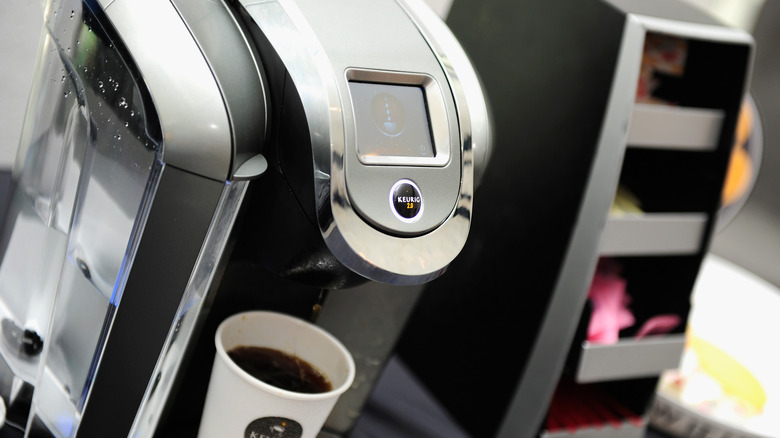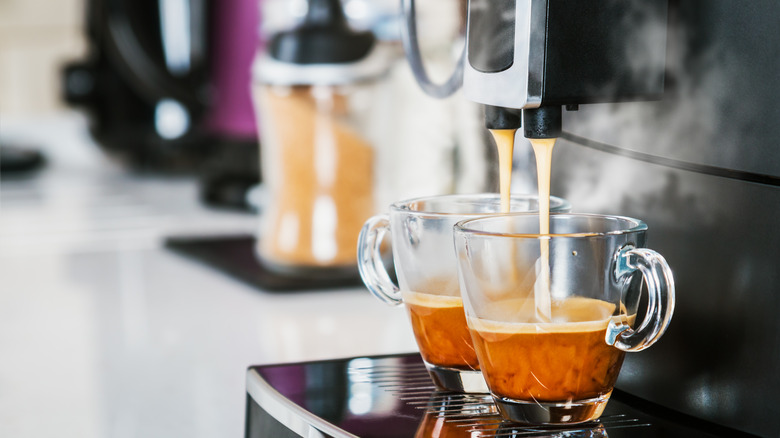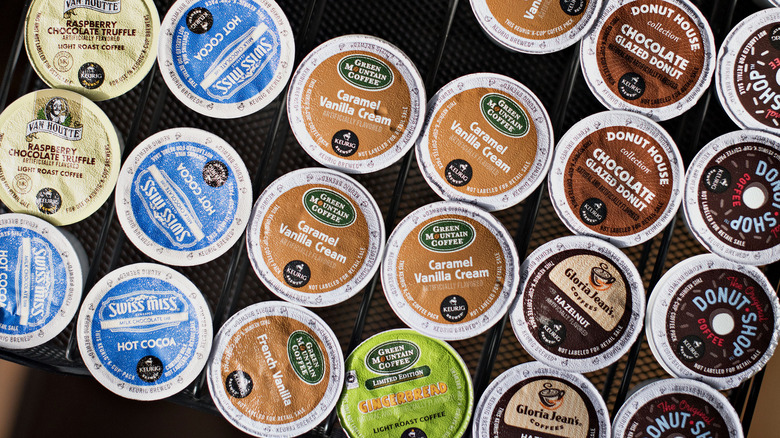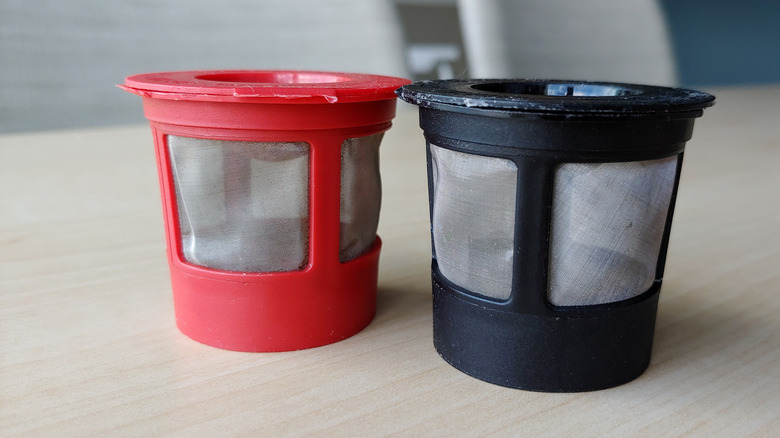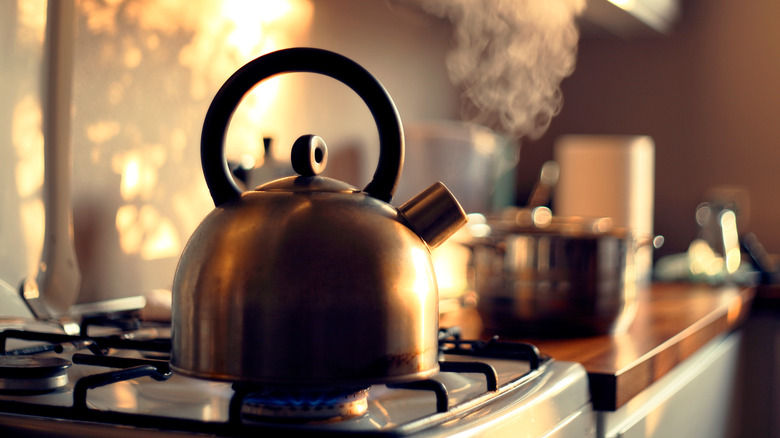So You Got A Keurig. Now What?
We may receive a commission on purchases made from links.
Maybe you need a cup of coffee first thing in the morning, even before your feet touch the floor. Or, you get through one too many coffees in a day and need a quick, convenient, and less expensive means of brewing grade A coffee. Maybe, the pandemic has caused you to appreciate brewing your own barista-style coffee at home. Whatever the reason may be, you have finally decided to take the plunge and invest in a shiny new Keurig to add to your kitchen. Congratulations, you are now one of the 33 million households in the U.S. to own a Keurig (via Xtalks).
With a Keurig, you really only need to plug the machine in, fill its tank with water, pop your favorite K-Cup in, press a button, and let the machine work its magic. Seconds later, you will have yourself a steaming hot cup of joe.
But, that's just the basics. How do you take care of your Keurig? How can you save money on K-Cups? How do you make your K-Cup pods taste even better? Sit tight! Here's everything you need to know about a Keurig now that you finally own one.
Clean your Keurig regularly
Cleaning the machine can do volumes to increase the lifespan of your Keurig. Not to mention, cleaning is the secret to making sure that you get the best tasting coffee from your K-Cup pods each time you use it.
According to Country Living, you should wipe the outside of your Keurig using a cloth and soap water at least once a week. Along with that, you should also wipe down the pod holder and the water tank, as well as empty the brown liquid from your drip tray every week, as damp environments are breeding grounds for mold and bacteria.
As with most coffee machines, a Keurig also requires descaling so that you get a good quality cuppa every time. Taste of Home recommends that you descale your Keurig once every three to six months, depending on how often you use the machine. While Keurig sells its own descaling solution with instructions on how to use it, if you would like to save some money, you can make your own descaling solution at home. Fill the water tank with half parts water and half parts distilled vinegar and run a brew cycle until the tank is empty. Run a cycle of fresh water to get rid of the vinegar solution after that. Similarly, you could also make a descaling solution with one or two tablespoons of any citric acid mixed with four cups of water.
Save more money with K-Cup subscriptions
To use your Keurig like a pro, it's a good idea to keep an eye out for K-Cup pod subscriptions, as these often come with discounts. Signing up for a coffee subscription on Keurig's website can help you save as much as 25% on the original price of each K-Cup box. There's also the convenience of K-Cup pods magically arriving at your doorstep just when you're running low on your pod supply. You can choose the intervals at which you want the pods delivered, as well as choose to pause, reschedule or cancel your subscription.
If you have one of the smarter and more tech-savvy Keurig machines (aka the one that lets you brew coffee with a click on your smartphone), you can also set your subscription up so that your machine automatically knows when you're running low on pods and orders them for you.
Amazon's Subscribe & Save is another great way to knock a few cents off each box of K-Cup pods. Once you have ordered your pods using Subscribe & Save five times, the 5% discount goes up to 15% for each order.
Make your Keurig brew stronger
Single-use pod-based coffee machines like the Keurig are notorious for making not-so-strong and watered-down versions of the real deal. This concern isn't entirely invalid, though. Business Insider explains that there are many reasons why the coffee made from a Keurig does not taste strong. For one, the coffee beans in the K-Cup pods are ground months in advance, which means that, by the time the pods reach you, the coffee is often stale. Keurig also does not heat water at a temperature high enough to extract the taste of the coffee as best as possible.
As with most problems, there's a solution for this predicament, too. Coffee Dorks suggests using two pods for each cup of coffee instead of only one. Rather than using one K-cup to brew an eight or ten-ounce cup of coffee, the site recommends using two pods and brewing a six-ounce pour with each. That is, if the extra-strong cup of coffee is worth going through your month's supply of K-Cups in half the time.
Another way to make your coffee stronger is by buying pods with dark roasted coffee. Keurig heavily dilutes the strength of coffee, so even a dark roast coffee will come out tasting lighter than it usually would.
Swap single-use K-Cups for reusable pods
Arguably, the greatest concern when it comes to choosing single-use pods like K-Cups is their negative impact on the environment. K-Cups are made with a mix of plastic, paper, and aluminum to keep the pods from leaking. Homegrounds reports that, while 5% of a K-Cup pod is made of recyclable plastic, 95% of the pod is non-recyclable at average, non-specialized recycling plants. The pods can take as much as 150 years to finally break down.
If you want to drink your Keurig brew without worrying about the carbon footprint that your coffee is leaving behind, you might want to swap K-Cups for reusable pods. Keurig sells its own reusable filters called My K-Cup, which you can fill with your own ground coffee and wash after each brew to be used again.
Reusable K-Cups also come with a few more perks. Remember the problem of weak-tasting Keurig brews because of stale coffee? With reusable pods, you can grind your coffee beans fresh every day to brew a strong batch of coffee (via Coffee Dorks). Plus, you can buy pretty much any ground coffee that you like and won't solely have to depend on the coffee selection that Keurig offers.
Leave your Keurig switched on and preheat it before each use
Once you switch on your Keurig for the first cup of coffee of the day, it takes anywhere between four to six minutes for the machine to heat up. Some would say that this beats the point of having an instant source of caffeine at home. For those 'some,' Coffee Stylish says the trick is to leave your Keurig switched on. If the machine is on at all times, it only takes 60 seconds to heat water between each eight-ounce cuppa and even less for the next one.
Cnet also recommends preheating your machine to make sure that the water's temperature is optimal for the extraction of coffee — between 195° F and 203° F (90-95° C). To preheat your Keurig, all you need to do is run a cycle of water without any pods in the machine first. Once you've done so, the site found that the temperature of the second cycle (when you actually brew your coffee), is 10 degrees hotter than the first one.
Use your Keurig as an instant source of hot water
There's no shame in admitting that waiting for a kettle filled to the brim with water to boil is more effort than it's worth sometimes. Lucky for proud Keurig owners, your Keurig can be an instant source of hot water.
Late-night pot noodles? Place the cup under the Keurig and run a pod-free cycle of water. You can also use your Keurig to pour hot water for a cup of tea or hot chocolate (via One Good Thing). Unlike kettle-boiled water that can sometimes be hot enough to burn your tongue if you aren't careful, brewing tea using water from Keurig means that the water will be at an optimal temperature for tea drinking. You can even use hot water from Keurig to bring instant rice to life (via Organized Mom)!
Besides, Keurig allows you to pour hot water in perfect measurements so you can make things like instant oatmeal, powdered soups, and pretty much anything that says 'instant' and requires hot water, with the ideal powder-to-water ratio.
